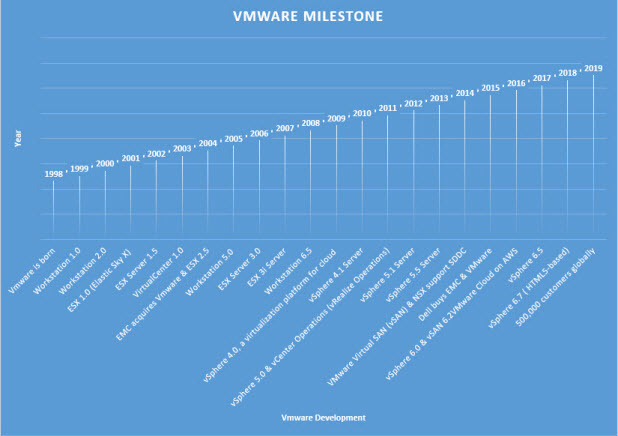VMware - Its birth and how the baby has
grown!
VMware vSphere leverages the power of virtualization
to transform datacenters into simplified cloudcomputing infrastructures
and enables IT organizations to deliver flexible and reliable IT services.
VMware vSphere virtualizes and aggregates the underlying physical hardware
resources across multiple systems and provides pools of virtual resources
to the datacenter.
VMware vCenter Server unifies resources from
individual hosts so that those resources can be shared among virtual
machines in the entire datacenter. It accomplishes this by managing
the assignment of virtual machines to the hosts and the assignment of
resources to the virtual machines within a given host based on the policies
that the system administrator sets.
The VMware story begins on February 10, 1998,
in Palo Alto, California. VMware presents its first product, Workstation
1.0, in 1999, which allows a user to run multiple operating systems
as virtual machines, all on a single PC.
In 2002 VMware releases the ESX Server 1.5, its
first hypervisor. ESX stands for Elastic Sky X. By consolidating multiple
servers onto fewer physical devices, this ground breaking product boosts
performance, streamlines IT administration, and even helps organizations
cut costs. VMware introduces vMotion, which allows users to move a workload
from one server to another, all while keeping the application running.
Today, the ability to seamlessly migrate virtual machines is an integral
part of nearly every virtualization deployment.
In 2003 The vCenter server provides a centralized management platform
that allows for simple deployment and automation of virtual infrastructures,
along with greater visibility and control for IT, and ESX 2.0, a new
edition of VMware, allows users to make their existing servers even
more efficient.
The EMC Corporation acquires VMware on January 9, 2004 and ESX 2.5
is released. followed in 2005 by Workstation 5.0 and ESX 3.0 in 2006.
In 2007 ESX 3i (Elastic Sky X Integrated) is
released and between 2009 through to 2012 vSphere 4.0, 4.1, 5.1 and
5.5 are released.
Fast forward to 2012 and VMware acquires network virtualization company
Nicira. A key addition to VMware’s Software-Defined Data Center
(SDDC) strategy, Nicira’s Network Virtualization Platform (NVP)
enables the dynamic creation of virtual networks that are independent
from physical network hardware.
In 2013 The launch of NSX brings about a completely
new operational model for networking. By moving entire networks into
software, NSX allows for a key security component, micro-segmentation,
vSAN, a core building block of the SDDC, is introduced in the same year
with the launch of vSphere 6.0.
In 2016 VMware and Amazon Web Services (AWS) announce the launch of
the VMware Cloud on AWS, enabling IT teams to manage their cloud-based
resources with familiar VMware tools, where customers can operate across
multiple clouds without restriction.
In 2017 vSpeher 6.5 is relaesed followed by 6.7
(HTML5-based) in 2018 and has over 500,000 customers globally.

Source: VMware
Timeline
In April 2020 PALO ALTO, Calif. – VMware, Inc.
(NYSE: VMW) announced the number of Virtual Cloud Network customers
now exceeds 15,000, including 89 of the Fortune 100 and eight of the
top 10 Telcos, and has grown on average 50% each fiscal year since May
2018. VMware’s Virtual Cloud Network solution is an integral component
of VMware Cloud Foundation, which is offered on all major hyperscale
cloud providers – AWS, Azure, Alibaba Cloud, Google Cloud, IBM
Cloud and Oracle Cloud – and uniquely enables VMware to make private
clouds as efficient and agile as public clouds and support business
continuity efforts.


